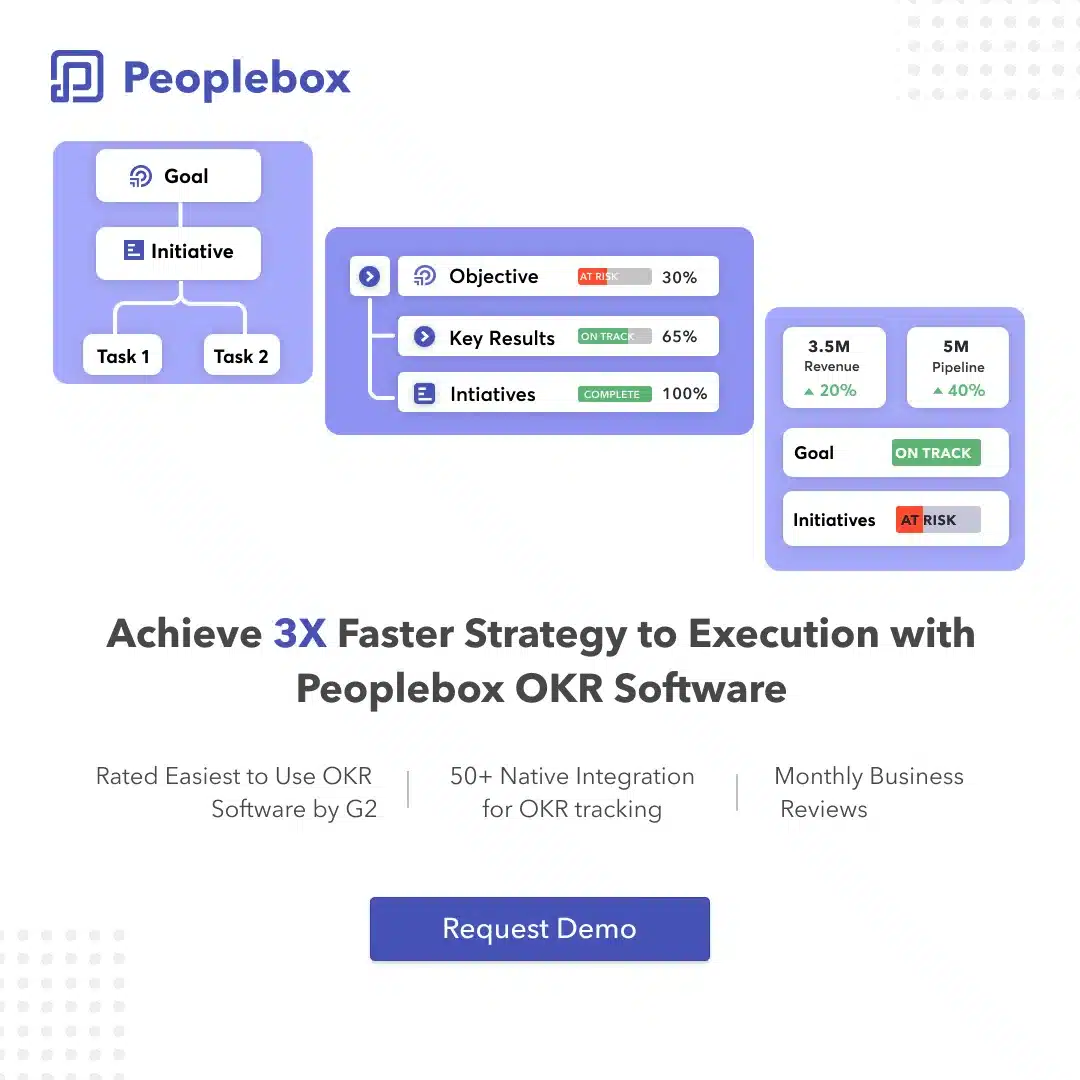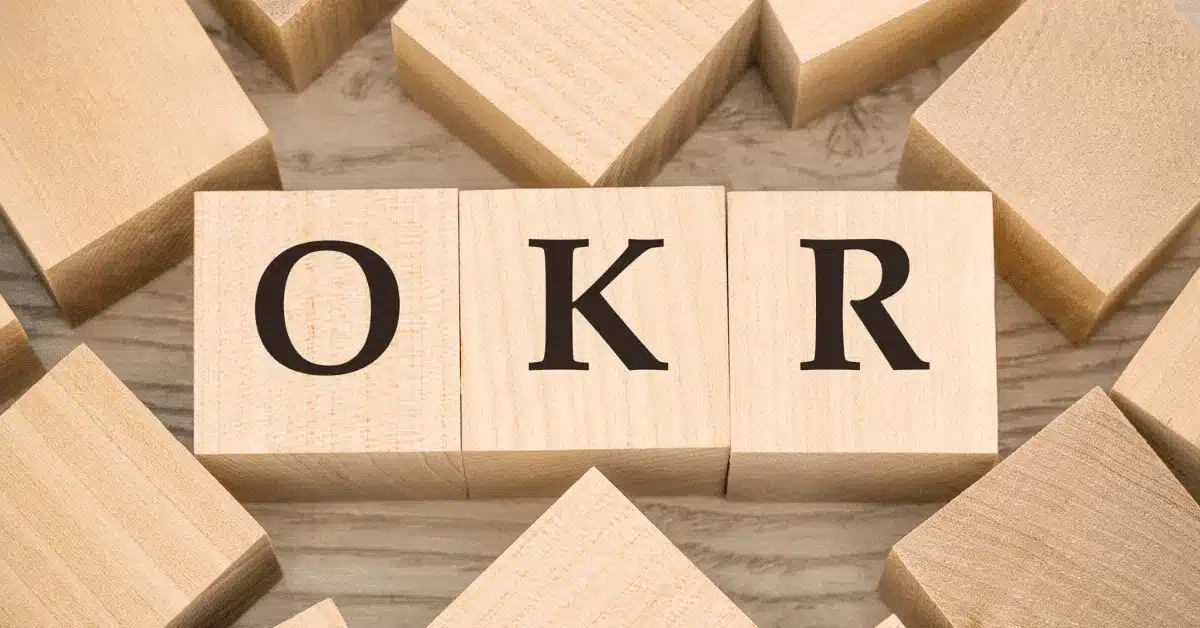As businesses strive for growth and innovation, understanding and implementing OKRs can significantly impact their performance and alignment.
This comprehensive OKR guide delves into the fundamentals of OKRs, providing clear OKR definitions, practical insights, and real-life OKR examples to help you harness the full potential of this strategic tool.
What We Have Covered in the Blog
In this detailed OKR guide, we cover:
- Definition and Importance of OKRs: We start by explaining what is an OKR, its purpose, and why they are crucial for modern businesses.
- History and Evolution: We explore the origins of OKRs, tracing their development from their inception at Intel to their widespread adoption in Silicon Valley and beyond.
- How OKRs Work: We break down the structure of OKRs, illustrating how Objectives define what you want to achieve and Key Results measure how you will accomplish these objectives.
- Benefits of OKRs: We highlight the advantages of using OKRs, including improved focus, alignment, transparency, and accountability within organizations.
- Real-Life Examples: To provide practical insights, we share real-life examples from successful companies that have effectively implemented OKRs, demonstrating their impact on business outcomes.
- How to Set Effective OKRs: We offer step-by-step guidance on creating meaningful and achievable OKRs, including tips on setting ambitious yet realistic goals.
- Common Challenges and Solutions: We discuss the common pitfalls companies face when adopting OKRs and provide solutions to overcome these challenges.
- OKRs vs. Other Goal-Setting Frameworks: We compare OKRs with other popular goal-setting methodologies, helping you understand their unique benefits and how they stand out.
- Tools and Software for Managing OKRs: We review various tools and software options that can help you manage and track OKRs effectively.
- Best Practices and Tips: Finally, we share best practices and actionable tips for ensuring the successful implementation of OKRs in your organization.
By the end of this OKR guide, you will have a thorough understanding of OKRs and how to apply them effectively to drive your business forward.
What is an OKR?

OKR, also called as Objective & Key Result, is a collaborative goal-setting methodology used by organizations, teams, and individuals to set ambitious goals with measurable results.
Some of the biggest tech companies in the world use OKRs including Google, Zynga, Upstart, and many others. OKRs were invented at Intel Corporation.
The Objective is “What do we want to achieve,” and the Key Results are “How are we going to measure the progress.”
The new generation OKR framework has one more component: “initiatives,” which are all the projects and tasks that will help you achieve your objective & key result.
History of OKRs
- 1954 – Peter Drucker published a book called “The Practice of Management“. In which, he introduced the concept of MBO— Management by Objectives
- 1970 – Andrew Grove co-founded and then CEO of Intel borrowed the idea of MBO from Peter Drucker and developed the concept of OKRs.
- 1974: In 1974, John Doerr joined the management team at Intel and learned more about the OKR framework.
- 1999 – John Doerr introduced OKRs at Google
- Current Day – More and more companies are adopting OKR as an indispensable part of their company culture.
What are the Benefits of OKR?
OKRs are a really powerful tool for teams to achieve exceptional business results through their 5 superpowers.
Focus
OKRs help to bring the strategic focus your team needs to drive great outcomes.
When you use OKRs, the first thing you do is to identify what are the key drivers for strategic impact, and once selected, OKRs let your team avoid costly distractions, say no to those thousand things and let them focus on what matters the most to the company.
Alignment
Most projects fail because-
1. The project is not aligned with the company’s strategy
2. cross-functional teams are not aligned on how they are going to contribute towards the success of the project.
OKRs help you bring both strategic alignment & cross-functional (Known as Horizontal) alignment.
As a team creates OKRs, they are supposed to align them to the larger objective and identify dependencies on other teams.
Accountability
OKRs help you build a culture of accountability as they create an outcome-based mindset and let your team be accountable for outcomes, not output.
OKRs demand you to keep a single owner for a Key Result hence empowering that individual to work more autonomously and be accountable for the outcome.
Click here to read how accountability is different from responsibility
Faster decision making
OKRs let your team make data-driven decisions faster as they are transparent.
With OKRs, everyone is aware of who is working on what and what is the status/progress on any goal.
With this real-time visibility, managers can also quickly identify where they should prioritize efforts to bring high impact.
Employee engagement
OKRs build a culture of high employee engagement as they demand strategic debate & discussions among teams and their leaders around strategic priorities.
These discussions increase their understanding of the company’s top priorities and how they are contributing.
To read about benefits of OKRs, particularly for remote teams in detail click here.
Which companies use OKRs?
- Intel
- Spotify
- Netflix
- Dropbox
- Accenture
- Deloitte
- Airbnb
- Oracle
- Bills & Melinda Gates Foundation
Click here to read about the OKR success stories of these companies
Types of OKRs
OKR can be broad of three types:
Committed OKRs
As their name suggests, committed OKRs are based on commitment.
Committed OKRs are expected to have a passing grade at the end of the cycle.
Aspirational OKRs
Aspirational OKRs are also known as stretch goals or “moonshots.” Getting to an Aspirational OKR requires a unique approach since no one has ever done it before.
Additionally, they may be long-term and linger beyond an OKR cycle, or even be transferred between team members to stretch employee engagement.
Learning OKRs
If the most valuable outcome for the cycle is learning something new, then learning OKRs is the best option.
In learning OKRs team is set to learn a new skill set required to achieve objectives in a set period of time. After learning the skill the results can be the OKR for the next cycle.
Click here to read more about Committed and Aspirational OKRs.
OKR Cycle

A typical OKR cycle has a set of activities that helps organizations to set, track, and achieve their goals aka objectives. It is for 60 or 90 days depending on the organization’s needs.
A typical OKR cycle consists of three steps – Set OKRs, Align OKRs and Achieve OKRs.
To get the most out of the OKR cycle organizations need to keep in mind two important things
The first is that only setting goals is not enough and it is crucial to align them across the company.
Also, it is equally important that all teams work together to fulfil them.
Secondly, organizations need to adapt to changing scenarios and be flexible.
This will help them to face uncertainties with higher efficiency and confidence.
Click Here to read about how a typical OKR cycles look and tips to make it successful
How to Write OKRs

In our experience, Writing OKRs are the most critical part of the process and vital to the success of OKR implementation in any organization.
Companies that spent significant time discussing strategic priorities & crafting OKRs can improve their overall strategy and align their teams easily.
To start with OKRs, you can use these formulas to write Objectives & Key Results.
What determines a good objective?
- A good objective is one that inspires and motivates the team
- Is clear and concise.
- Is qualitative and not quantitative
- Has a clear purpose and direction
- Is aligned to the company’s strategic priority
What determines a good KR?
- A good key result is one which is measurable
- Measures outcomes instead of outcome
- Progress in key results should be reflected in the Objective too
- Clear and concise
- Challenging but attainable
OKR Examples
Below we have listed a few companies, Teams and roles OKR Examples. For 100 + OKR templates for different teams download our ebook OKR templates designed especially for hypergrowth startups.
Company OKR Example
Objective: Win the B2B HR Tech Market in order to emerge as a leader
KR1: Increase Monthly Recurring Revenue (MRR) by $200,000
KR2: Keep monthly customer churn below 5%
KR3: Lower overall expenses by 5%
Marketing Team OKR Example
Objective: Build a pipeline that gives the highest closer rate ever
KR1: Build a 10mn USD qualified pipeline
KR2: Get 200 demo meetings held with the target personal
KR3: Improve account to demo ratio to 5% for ABM Campaign
Click here to get ready to use and easily customizable 100 + OKR templates
Chief of staff OKR Example
Objective: Increase goal alignment across the organization
KR1: Increase OKR adoption to 100% by ensuring everyone owns OKR in the organization
KR2: Reduce the number of misaligned objectives to zero
KR3: Increase the weekly check-ins per KR from 0.7 to 1
For more OKR examples for different teams and roles click here
How many OKRs should I have?
In our experience, one of the common mistakes teams make in their early time with OKRs is that they try to represent everything they’re doing in their OKRs and end up having 8-10 OKRs. This is one of the major reasons OKR fails.
The primary purpose of OKRs is to instil focus.
OKRs should not be used to track business-as-usual activities but to track what matters most. Hence we recommend keeping them as minimum as possible.
John Doerr, author of “Measure what Matters” recommends that each team can have a maximum of 5 objectives with 3-5 key results each.
Christina Wodtke, author of “Radical Focus” claims companies should manage just one Objective and its Key Results.
Why OKR Reporting should NOT be manual
Most startups when starting their OKR journey by creating updating, and sharing their OKRs manually using OKR Spreadsheets, Google Docs, PowerPoint, etc.
The set OKRs are then shared through internal communication channels like Slack, emails, intranet, etc.
This practice is ok when the company is just in the initial phase one the company expands and they dive deeper into the OKR ocean they fail.
Because their OKR reporting method is outdated which leads to broken links in OKRs.
To avoid this companies should always use an updated OKR tool which will help them to manage and report their OKRs to teams in a more systematic way.
OKR Process: From Creation to Review
Define cadences & timeframes
The basic step to creating any OKR Process is to define how often you will be creating goals at the company & team levels.
Keeping agility in mind, We recommend having annual company OKRs and quarterly team OKRs.
Click here to read how to set the right OKR cadence
Check-in & progress review frequency
How often should OKR owners update their Key Results? How often should teams meet to discuss progress on OKRs?
Most OKR program fails because of the “Set it and Forget it” mentality.
To ensure the program succeeds, you should clearly define a frequency at which owners should update & review progress on their goals. Most companies do it weekly.
3 Approach for OKR Alignment
There are two ways to achieve alignment through OKRs.
Top-down
In this approach, the CEO sets the OKRs for the entire organization and then teams and individual set their OKRs accordingly. This is good for alignment.
Bottom-up
In this approach, employees set their OKRs and align them with the company’s vision. This fosters engagement but requires a clear vision & mission statement from the company.
We recommend that Top-down is the best approach as it helps align all teams and employees across the company toward the same overall goals.
Click here to read about OKR process in detail
How to get Leadership Buy-In for OKRs
For making the most out of OKR it is necessary that the leaders are ready to accept the OKR framework. Imagine if the senior leaders are not ready to adopt OKRs how can you expect the rest of the employees to accept it.
We’ve experienced that when an organization is adopting OKRs, it’s hard to get everyone on board as It requires the entire organization to break old habits and adapt to a new mindset of focusing on outcomes rather than on output.
- Tell the leaders the benefits of OKRs and how they will help the organization to improve
- Provide them with proper training on OKRs which will make OKR implementation easy for them
- Give them OKR case studies and take out the fear of OKR failure from them
- Hire an OKR consultant who will help to answer all the queries related to OKRs
Read this blog to get simple tips to get leadership buy-in for OKRs
Why appoint OKR champions
Hence the role of the OKR Champion is critical to the successful OKR implementation in any organization.
“For organizations that attempt to roll out the goal-setting framework without OKR Champions, there is a greater risk that the framework won’t be adopted well or at all.” – Joe Ottinger, Co-founder, OKR Advisors
Also, It’s better to build a team of OKR champions instead of just one person. You might want to have an OKR champion for each team so their peer can follow them to adopt the best OKR practices.
While choosing an OKR champion, you might want to look for these characteristics:
- They are part of your company, not external consultants.
- They have experience in working cross-functionally.
- They are enthusiastic about OKRs
- They are empathetic, Organized & Committed.
- They love mentoring/coaching
The role of OKR Champions is to lead the adoption of the OKR framework and communicate its value.
They should set examples for their peers, especially when it comes to writing, tracking, and reflecting on OKRs. They will own and ensure the success of your OKR program.
How to roll out company OKR
For successfully rolling out the company OKRs it is recommended to create two cadences and set annual and quarterly objectives for the company. It helps everyone see things from long-term and short-term perceptive.
Annual Objectives
The leadership team has to create annual OKRs based on their strategic priorities for the year. Most companies often mistake their annual OKRs with their annual plan and end up listing all the things they want to do. We recommend keeping the annual OKRs short and identifying the top 3-5 strategic priorities for the year for creating annual OKRs.
Annual VS Quarterly OKRs: Which is Better for you
Annual OKR Examples
| Objective | KR 1 | KR2 | KR3 |
| Win the B2B HR Tech Market in order to emerge as a leader | Increase Monthly Recurring Revenue (MRR) by $200,000 | Keep monthly customer churn below 5% | Lower overall expenses by 5% |
Quarterly Objectives
Once you have your annual objectives, It is easy to prioritize for the quarter. The leadership team has to write quarterly objectives aligned to achieve annual objectives.
Quarterly OKR Example:
| Objective | KR1 | KR2 | KR3 |
| Expand Into EMEA Market | Get 300K in MRR from EMEA Market | Increase website traffic from EMEA by 50% | Keep CAC below 5K |
Click here to read about how to roll out OKRs and best practices to follow
Check-ins Regularly
Most goal management system fails because of the “set it and forget it” mentality. Hence ensuring proper check-ins to goals is mandatory.
If you are using Google Sheet, It is difficult to get updates on each goal but with OKR software like Peoplebox, you can create automated reminders to nudge employees over Slack, Microsoft Teams, and Email.
With Peoplebox, You can also let your employees check in on goals directly within slack. This has been very effective for many companies as it does not require them to log in to another platform.
Use Integrations
Even after doing follow-ups & sending automated nudges to employees for check-ins on their OKR, leadership often fails to get timely updates on goals & projects.
And teams find it difficult to collect data from 20 different tools to update it at one place for leadership.
With Peoplebox Software, You can integrate the tools you are using to track your KPIs & goals and update key results & project status automatically.
Companies have seen better OKR adoption while using integrations. It saves 100+ hours of team’s time in updating goals and teams find it easier to use the real-time data to prioritize their efforts and make faster decisions.
Read about how OKR and slack integration can help you save time and keep you top on your goal.
Use 1:1s
Are OKR part of the conversations your teams are having?
In Peoplebox, We have built our one-on-one meeting tool with OKR integrations which help teams do conversations around team & individual priorities and help them align better.
Also Read: Why you should integrate OKRs and 1:1s

How to conduct OKR review meetings
To drive exceptional business results, You need to use the OKR data to prioritize better and make faster decisions.
With Peoplebox Software, it is super-easy as you have updated & aligned goals, KPIs & Projects in a single place whenever you want.
Most teams set up their review meetings once a week mostly on Monday/Tuesday to discuss the progress and set priorities accordingly for the next week.
In the review meetings, You should discuss:
- The progress of key results and update the status of each objective
- Put a comment on all initiative’s progress
- Discuss objectives that are at-risk & behind
- Check if there are objectives & key results without check-ins as this will inform you what’s moving and what’s not.
After the review, your employees will have a clear understanding of their progress towards their goals and will be able to identify what’s working and what’s not working.
To make the best use of your time, We recommend that get your team do check-in before the meeting and add their comments.
End of Month OKR review
Unlike a weekly review, monthly OKR reviews should include someone from leadership.
The agenda for the meeting should be to
- Review at-risk & behind objectives
- Discuss blockers for key results
- Plan out course correction if required.
End of quarter OKR review
If you have a quarterly cadence then it’s important to have an end-of-quarter OKR review meeting to reflect on how employees, teams, and the organization did at achieving their goals.
This review meeting helps you demonstrate that the company is committed to OKRs. It also gives you a platform to appreciate teams for their effort.
Apart from these benefits, it also helps you understand what worked for your OKR program and what didn’t. Here are a few questions you should ask while doing the review.
- How is the progress on company goals?
- Were there any misaligned goals on which your team spent their time?
- Were you able to align cross-functional teams and capture all dependencies?
- Were there any mid-quarter changes in key results & initiatives? If Yes, Why?
Scoring OKRs & End of Cycle Review
At the end of the OKR Cycle, Let your managers score their OKRs on a scale of 1-10 based on the progress.
It is recommended that managers should have 1:1 discussions with each of their team members to review their OKRs and give feedback. This should be a two-sided conversation where managers and their direct reports can discuss openly the progress on OKRs, what mistakes they did, lessons they learned, and aligned better for the next quarter.
Managers can also explain the reason behind the score.
Click here to read about how to Wrap up quarterly OKRs and prepare for next quarter OKRs
Kick-off planning for next OKR cycle and rollover
Repeat it again but with more learnings and power. Draft Your OKRs again and update them in the OKR tool.
Bonus:
5 Reasons Why Frequent OKR Review Meetings are Important
5 Tips On How To Run An Effective OKR Progress Review
10 Questions You Should Ask in Your Next OKR Retrospective
What OKR tools are available?
If you are just starting your OKR journey you can use free OKR tools like Google Docs and Google Sheets, or even this can be done on pen and paper.
But, in the long run, this is not a good practice and it will be beneficial for you to invest in an OKR software.
Do not forget to check out the top 10 features of an OKR software must-have.
OKR vs Different goal setting frameworks
OKR is the most talked goal setting framework in the town, but there are other goal setting frameworks also around.
Check out the 14 goal setting methods which are used by most companies around the globe.
Below we have also listed the difference between OKR and other goal setting frameworks.
OKR and KPI – How they are different but crucial for the organization’s growth

OKR and KPI – are the foundation of the success of any organization. But a question often arises if you are already having KPIs then is it necessary to have OKRs ? If yes, how are they two different! Below is the answer
| OKR | KPI |
| The process to achieve goals is also taken into account | KPI focuses mostly on the outcome |
| OKR is more about the ultimate goal organization is trying to achieve. | KPIs are often project-related and aim to scale or improve the project. |
| OKR is temporary in nature and change from time to time | KPIs are specific and don’t change from time to time. |
OKR vs MBO
MBOs help teams identify their primary objectives or goals and set priorities between outcomes and activities.
The OKR is a refined version of MBO, which provides more clarity by explaining what success for the organization means.
Measurable key results help teams achieve their objectives. OKR give purpose to companies and teams.
To get detailed insight about OKR vs MBO click here.
OKR vs tasks
OKRs are often confused with tasks. But, there is a difference between them.
Tasks are something that you have to do on a daily basis where whereas OKRs are generally quarterly or yearly.
The second difference between OKRs and tasks is, that tasks are activity-based whereas OKRs are value-based. Let us understand this by the below-mentioned example
Example,
Create an engagement program – Tasks (activity-based)
Improve employee engagement from X to Y- OKR (value-based)
Click here to read more about OKR vs tasks
Must read OKR books
There is a lot of information about OKRs you can read on the internet. Yet for the best information about OKR methodologies, one must turn to experienced practitioners.
OKR is something that needs a lot of practical practice and cannot be learned overnight. To become an expert you must read books that provide practical solutions to all challenges.
Below is the list of best OKR books in the market
- The Beginner’s Guide to OKR by Felipe Castro
- Focus: Achieving Your Most Important Goals with OKRs by Christina Wodtke
- Work Rules by Laszlo Bock
- How to Measure Anything by Douglas W. Hubbard
- Objectives and Key Results – Driving Focus, Alignment, and Engagement with OKRs by Paul Niven and Ben Lamorte
To read more about these OKR Books click here
Why and when should you hire an OKR Consultant
If you are implementing OKRs for the first time or if you are struggling with your OKR cycle consider taking help from an OKR consultant. An OKR consultant will help you with the OKR process and will ensure that the best practices of OKR are followed.
OKR consultant will help you in –
- Getting buy-in from senior leadership and teams for OKRs.
- Will help your teams to get started with OKRs.
- Will help your teams in goal setting and/or measurement.
- Will train your OKR champions in making the OKR process smooth.
- Will help you in cascading OKRs throughout the organization.
- Help you with proper OKR tools and software
- Establish an OKR process
Conclusion
Implementing OKRs can be a transformative step for any organization seeking to improve focus, alignment, and performance. This powerful goal-setting framework, used by some of the world’s most successful companies, provides a clear roadmap for achieving ambitious objectives and measurable results. By understanding what is an OKR, learning from real-life examples, and following best practices, your organization can harness the potential of OKRs to drive significant growth and innovation.
Whether you are just beginning your OKR journey or looking to refine your existing processes, this OKR guide equips you with the knowledge and tools needed to succeed. Remember, the key to effective OKRs lies in setting clear, ambitious goals, measuring progress rigorously, and fostering a culture of accountability and transparency.
As you embark on your OKR implementation, keep in mind the benefits of this framework: enhanced focus, improved alignment across teams, greater transparency, and increased motivation. Embrace the challenges, learn from the experiences of others, and continuously refine your approach to OKRs. With dedication and the right strategies, you can achieve remarkable results and propel your organization towards its highest aspirations.








